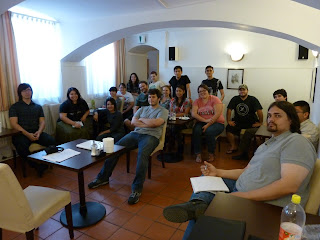In the Music in Vienna class we talked about Beethoven, in anticipation of our afternoon visit to one of his apartments. We discussed his career, his music and his life here in Vienna. In the Intro to Opera class we discussed Christoph Willibald Gluck, the 18th-century opera reformer who began and ended his career here in Vienna, and was a favorite of Empress Maria Theresa and her daughter Marie Antoinette.
After lunch we headed to the Inner City for a tour of the Musikverein concert hall. This is generally considered by experts to be one of the three concert halls with the best acoustics in the world. This is where several of us heard the Vienna Philharmonic rehearsal on Tuesday, and now all of us got to see it. Our tour guide showed us the entrance foyer, and then took us into the main hall ("Grosser Saal"), also known as the "Golden Hall," as you will see from the pictures.
This is our tour guide talking to our group in the Golden Hall:
We learned some of the reasons the acoustics are so good in this hall. For one thing there are empty spaces both under the floor (originally planned as storage space) and above the ceiling (it is actually not attached at the edges, but instead hung from the roof, creating an empty space between the roof and the ceiling). These spaces act as resonating chambers, kind of like the inside of a violin or guitar. In addition, almost everything is made of wood, including the seats, all of the walls and decorations (they are faux marble, but made of wood) and the parquet floors. Finally there are many decorative statues and ornamental designs throughout the hall, making for ample reverberating surfaces.
As we were finishing our tour
of the Golden Hall, the Vienna Philharmonic members were slowly gathering and warming up for a rehearsal. Here is our group in the Musikverein Golden Hall:
After the Golden Hall, our guide took us into the Brahms Hall. This is the hall for chamber music in the Musikverein. It was named after Johannes Brahms because he was a director of the Musikverein for several years during the late nineteenth century. The building was built in the 1870s and the Golden Hall and Brahms Hall were the two original halls in the structure. Today, they have added five more halls for a total of seven halls in the complex, several being underground, and some being mostly used as rehearsal halls. But we have noticed from our two visits here so far that the Vienna Philharmonic seems to always get the Golden Hall for their rehearsals!
This is a photo of a few of our students in the Brahms Hall:
And here is Ramiro and Anubis with the hall's namesake. By the way, that's not Ramiro or Anubis in the middle.
The Brahms Hall is famous for its premiere concert. The very first performance in this hall was a piano recital by none other than Clara Schumann. For this she gets a bust in a prominent position in the lobby of the Musikverein.
Finally, when we left the Musikverein, the group posed for a picture out front:
After the Musikverein tour, we all got on the U4 subway line and headed to the last station northwest of the city center, Heiligenstadt. Beethoven lovers will know this name from the famous document he wrote to his brothers describing the despair he felt over the knowledge of his oncoming deafness, the Heiligenstadt Testament. In the suburb of Heiligenstadt, there is a well-preserved apartment where Beethoven lived during this time in his life. There is not much to the apartment, a couple of rooms, a courtyard and a garden, but there are a few interesting artifacts inside, including Beethoven's death mask and a lock of his hair.
Here is Brittany and Anthony taking photos of a Beethoven manuscript:
The garden at the rear of the building:
Here is the group in the courtyard on the steps to the entrance of Beethoven's apartment:
The suburb of Heiligenstadt has several cobblestone streets near the Beethoven house that are virtually unchanged since Beethoven walked on them 200 years ago. Also, there is a small creek along which Beethoven walked each day when he lived in Heiligenstadt. It is said that this creek gave him the inspiration for many of the themes in his 6th Symphony, the "Pastoral" Symphony. Today there is a "Beethovengang," or "Beethoven Walk," next to this creek. And of course, we walked along the path.
This ended our day with the Musikverein and Beethoven. On our way back to the tram stop, we stopped for some refreshments at a typical Viennese Heuriger, which are country, family-owned wine gardens in the Vienna Woods, the easternmost extension of the Alpine mountain range. Heiligenstadt, although a Vienna suburb, is situated on the edge of the Vienna Woods, and has many Heuriger restaurants.
Many of the students had concerts to attend this evening so they rushed back to Vienna on the Strassenbahn (tram) to make the starting times.











No comments:
Post a Comment